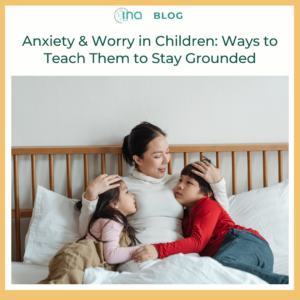 Worrying: we all do it – it’s a normal part of life, even for kids. Worry often comes when we anticipate a stressful or negative outcome for a situation. For some people – even children – worry can become a deeper issue that grows into anxiety. This can often be distracting and even debilitating. Here, we’ll discuss some ways you can help the children in your life deal with worry and anxiety, helping them stay grounded and able to manage those feelings on their own.
Worrying: we all do it – it’s a normal part of life, even for kids. Worry often comes when we anticipate a stressful or negative outcome for a situation. For some people – even children – worry can become a deeper issue that grows into anxiety. This can often be distracting and even debilitating. Here, we’ll discuss some ways you can help the children in your life deal with worry and anxiety, helping them stay grounded and able to manage those feelings on their own.
#1: Identify signs of anxiety.
Anxiety can present in a variety of different ways. It might mean that your child is grouchy or reactive, has more meltdowns or tantrums, is more sensitive or clingy than normal, or talks about their phobias or fears regularly. They might have nightmares about certain potential situations, have obsessive thoughts or actions, or physically show their anxiety before going out somewhere or taking part in an activity. When you recognize these things, it’s important to encourage them to share their feelings. Listen to them and stay calm and patient – even when they are demonstrating big emotions. Leading by example with a calm and gentle demeanor can go a long way in helping your child center and ground themselves. It also helps them feel more comfortable about opening up about what they’re feeling.
#2: Learn some grounding techniques.
There are a variety of different techniques out there that help ground your child. The first is the 5-4-3-2-1 grounding exercise that uses their senses. First, have the child identify five things they can see, four things they hear, three things they can smell, two things they can touch, and one thing they can taste. This is an effective way to bring children back to the present and help their mind slow down and stop racing thoughts. After they do this, encourage them to take slow, deep breaths – in through the nose until the belly expands, then let the air out after a couple of seconds. While they are doing this, encourage them to release any negative thoughts and feelings. Repeat this as often as needed until they start feeling a greater sense of grounding and peace.
#3: Stay active.
Sometimes children can work out their anxious feelings through physical activity. Often, just a simple walk around the block can ground their minds and bodies. As they walk or run, talk to them about being aware of their steps, paying attention to the sights and sounds around them. This brings them back to what’s right in front of them and takes them a bit ‘out of their head’ and back into reality.
Life is full of ups and downs and helping teach children ways to cope with the stresses of life is important. Giving them the tools they need to stay in control of their minds and bodies is important as they grow up and experience things. By learning how to gather their emotions and stay in control of them, they can help reduce feelings of anxiousness and stay grounded.
